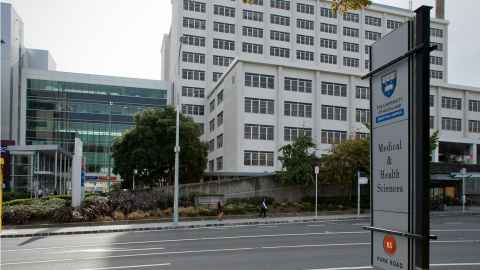Clinical partners
The establishment of strong clinical partnerships with Auckland City Hospital assisted the school to develop robust teaching and placement programmes.
Proximity
One of the advantages of having a School of Nursing situated in the University of Auckland was the proximity to Auckland City Hospital. The school worked with the hospital to provide clinical experiences for nursing students in both undergraduate and postgraduate study. This enabled clinical lecturers to be in close contact with students while they were completing their clinical placements.
Another advantage being over the road from the hospital was the access to clinical spaces. When the undergraduate nursing papers were being introduced, the development of a clinical room was still in the early stages. Auckland City Hospital provided spaces for practical learning before these could be established at Grafton Campus.
Clinical partnerships
The establishment of strong clinical partnerships enabled the school to develop robust programmes. Mia Carroll, the Director of Nursing at Auckland District Health Board (ADHB) between 1999 and 2002, played a central role in the development of the relationship between the University of Auckland and ADHB. Other nurses, such as Jane Bebbington, joined the teaching team on a part-time basis to develop postgraduate courses, starting in July 1999.
"Lyn Dyson [Senior Lecturer in Nursing] actually approached me and said, 'There's a new school of nursing, postgraduate school of nursing opening up,' and I think she said, 'We would like you to join the team. Would you consider it? Because we want to start looking at advanced care roles'."
Jane Bebbington
Clinical Nurse Educator in the Department of Emergency Medicine, Auckland District Health Board

The following year, School of Nursing staff worked closely with Auckland City Hospital to develop the undergraduate degree and provide clinical placements that would support learning and respond to the needs of the clinical area.
Clinically-anchored staff
When recruiting staff for the School of Nursing, it was important to attract people who were both academically strong but also clinically active. This was highlighted as something that had been missing from other schools around the country.
"We looked and sought good staff clinically and educationally. Some people might have more education and others might have more of clinical, but we held onto that. And to this day we have some staff who are vital to the school."
Associate Professor Judy Kilpatrick
Head of School and Associate Professor (1999-2017)
It was considered a benefit having lecturers who were still practising clinically to close the theory-practice gap and to make the teaching more relevant and applicable.
"I think sometimes when people go into education, they lose their clinical confidence. So, to have people who were clinically anchored teaching it seemed like a much more opportune way of reducing the theory-practice gap and making sure that what we were doing was real and possible."
Mia Carroll
Director of Nursing (1999-2002)
Recruiting staff who were academically well-prepared and clinically-connected paid off in other ways. The school was able to engage in clinical research and consultancy.
Matthew Parsons was employed as a Senior Lecturer and maintained a clinical role as a clinical nurse consultant in older person rehabilitation.
"It was inevitable because [Judy Kilpatrick] was actively recruiting people who both had PhDs and were working clinically to the top of their game. It was inevitable that we would be used to work clinically and develop services."
Professor Matthew Parsons
Senior Lecturer (1999-2008)